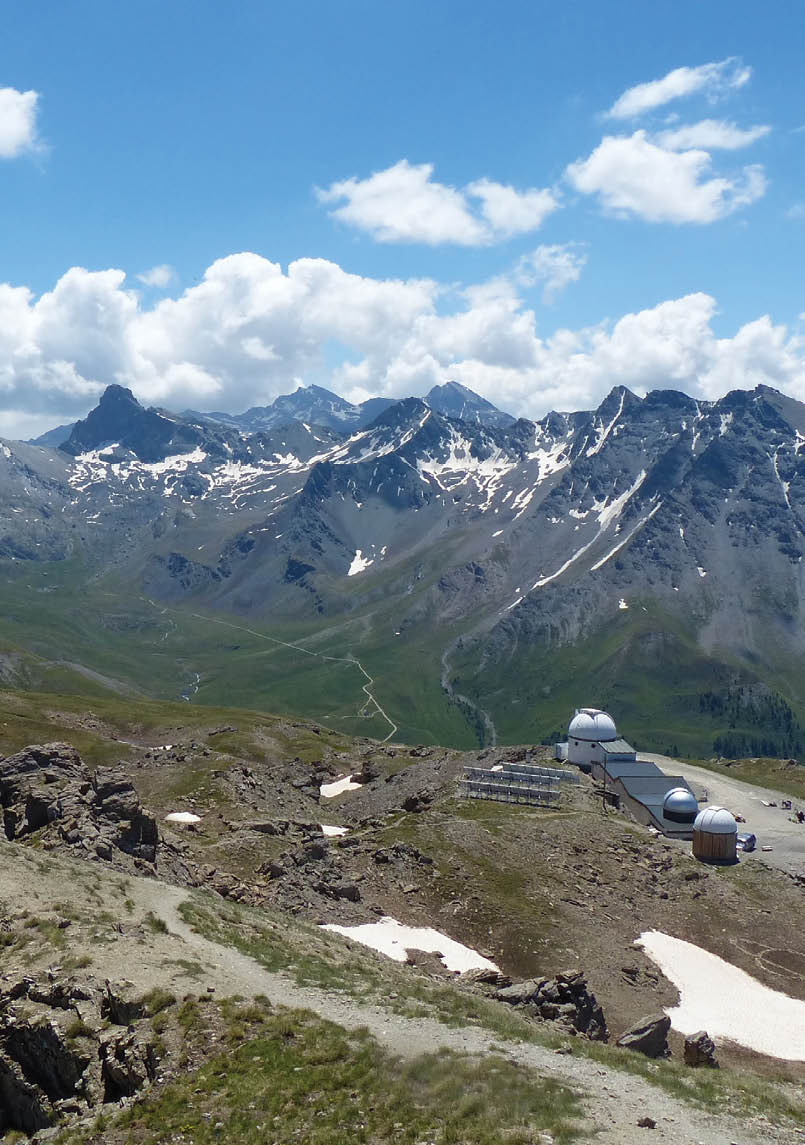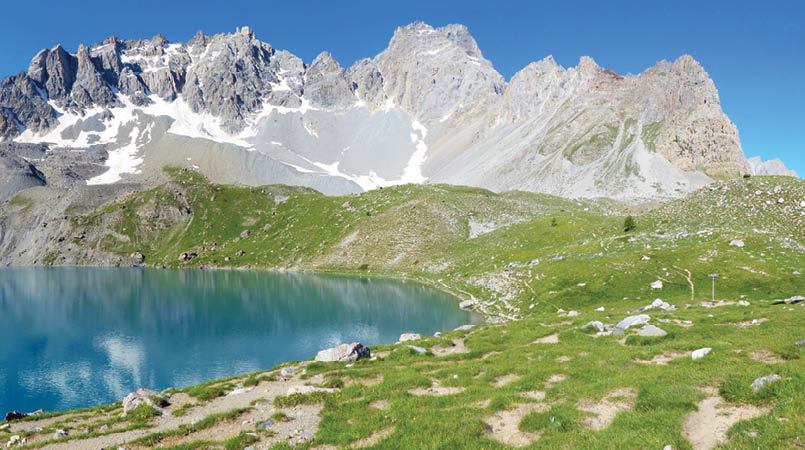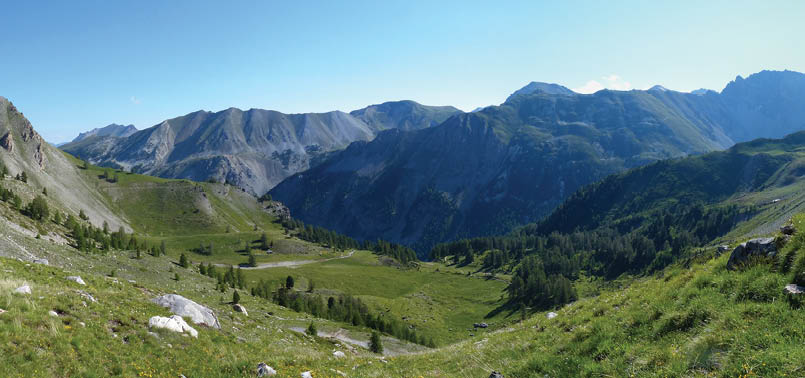


Saturday, 6am. That’s two hours earlier than when I get up for work during the week. But I like getting there early for a walk - less people, more chance of wildlife encounter. The Alps are special. I’ve learnt over the years that wherever you go, whenever you go, there’s always someone there exploring, picking blueberries, camping, birdwatching or just enjoying the fresh air. You can’t just walk for fifteen minutes and escape like in Australia. It requires more planning.
View from Pic de Château Renard toward the observatory

French Alps
Nicolas Bertin

20 | BWA February 2017

An icy morning in autumn can make for the most dangerous conditions on a steep track. Winter is even worse. You need low avalanche risk combined with good weather on week-ends. Spring means avoiding the shady spots where névés, those hard compacted snowfields, can turn a nice stroll into perilous walking where you have to carve steps on the side of a steep drop. Summer means having to wake up even earlier to beat the crowds. Most car parks are full by 10am in July and August.
But it’s worth it. I live in Grenoble. This means I have numerous mountain ranges less than two hours from my home: Vercors, Chartreuse and Bauges are three “low” mountains ranges, i.e. less than 2500 metres. Belledonne, Grandes Rousses, Aravis and Taillefer are 3000 to 3500 metres high. Then you can find the big daddies: Ecrins, Vanoise, Mont Blanc. They’re rugged, with summits above 4000 metres, cascading glaciers, and tough people.
But this morning, it’s none of those I’m heading to. I’m heading to one of my favourite places: Queyras, a mountain range long forgotten. Well known by cross-country skiers and seasoned walkers, it’s the last fully authentic range in the French Alps. Ski slopes can be counted on one hand, it’s home to the highest town in Europe (Saint-
Véran, 2042 metres), picture-perfect alpines lakes, gorgeous autumn colours with the larches, a rocky desert with surreal spires, and easily accessible 3000+ metres peaks. It’s one of those places that impacts you instantly. You feel at home.
It’s early July. A late spring meant you couldn’t walk very high in June: too much compacted snow, dangerous conditions. But now the flowers are in bloom, and the snow has finally receded. The first walk of the weekend is my first 3000 metre peak ever. Well, 11 metres shy of 3000 metres to be honest. Pic de Chateau Renard is known for the observatory built near the summit. It’s an easy peak, nothing technical. With 1000 metres elevation gain, it’s also nothing unusual in the Alps. But above 2500 metres, I feel the altitude and progress is a lot slower. Some people feel it at 2000 metres, some don’t feel it until 4000, everyone’s different, and it’s not about physical fitness.
The walk starts near a river, and climbs steeply in flower meadows. At 8:30am I’m alone. It was worth getting up early. Amongst the trees and flowers, it’s pleasant, with enough shade not to suffer too much. Soon I reach the treeline and end up in a large valley. A couple of marmots play hide and seek, and then I scare off a herd of chamois, one of the two types of mountain
Lake Sainte-Anne
BWA February 2017 | 21

Nicolas is a French physicist who fell in love with bushwalking during a two year job contract in Melbourne, walking extensively in Tasmania and Victoria. He returned to Grenoble in France, near the French Alps, and has been exploring many regions of the Alps since. He walks in all seasons: crampons for icy conditions, snowshoes in winter, and long day walks the rest of the year. He loves travelling, and has been lucky enough to explore some of the mountains of New Zealand, Norway, the United States and Canada.


goats native to the French Alps. Having reached the 2500 metres limit from which I usually start coughing up my lungs, I start to progress more slowly. But then I reach a nice saddle, col de Longet, offering me great panoramic views. I see Italy in the north, already in the fog. In summer, moisture from the Pô plain gets heated and results in a sea of fog every afternoon. You can observe this phenomenon best on the col de la Traversière walk, where an ancient tunnel for merchants with mules carrying salt between Italy and France was carved in 1480. Luckily the French side doesn’t have the fog.
The second part of the walk follows a dirt road to the observatory. It’s not very glamorous, but at least progress is easy. After the observatory, it’s a short steep walk on rocky terrain to the vertiginous summit. Queyras is very rocky and wild, no glaciers. The view is spectacular.
On the way back to tonight’s camp ground, I enjoy Queyras’ authenticity. Old chalets in picture perfect villages, wood-working artisans born from the necessity of staying busy in winter, bee-keepers, and of course cheese farmers. The camp ground is small, there’s no individual camp site, but it’s cheap. Hard to beat 7€ per night with showers and flush toilets. I’ve underestimated the cold though: it hit almost 0°C that night, on a sunny July weekend.
The next day I picked an easy hike, only about 400 metres elevation gain. But it’s one of the most spectacular in the region.
Although quite rocky and dry, there are many lakes in Queyras. Amongst the most beautiful is lake Sainte-Anne. The start of the walk is steep but in the forest it's enjoyable. Then the views open towards a small valley and a nice waterfall fed by the lake. With a final push, I reach the lake itself. It’s one of those gorgeous amphitheatres the Alps are famous for. A perfect turquoise lake fed by melting snow, rocky peaks in the background, the traditional cross, and a nice little chapel.
I’m too tired to climb further, so I just enjoy the view, battling an annoying wasp. With no ski resort in sight, Queyras is one of the last refuges for people like me. Many hidden valleys in the Alps offer the same feeling, but Queyras is a whole region. Sure it’s not wild like Australia, but nowhere is it like that in Western Europe. You come to the Alps for the special relationship between people and mountains. And nowhere in France is it more poignant than here.
Fond de Chaurionde from Lake Sainte-Anne
22 | BWA February 2017